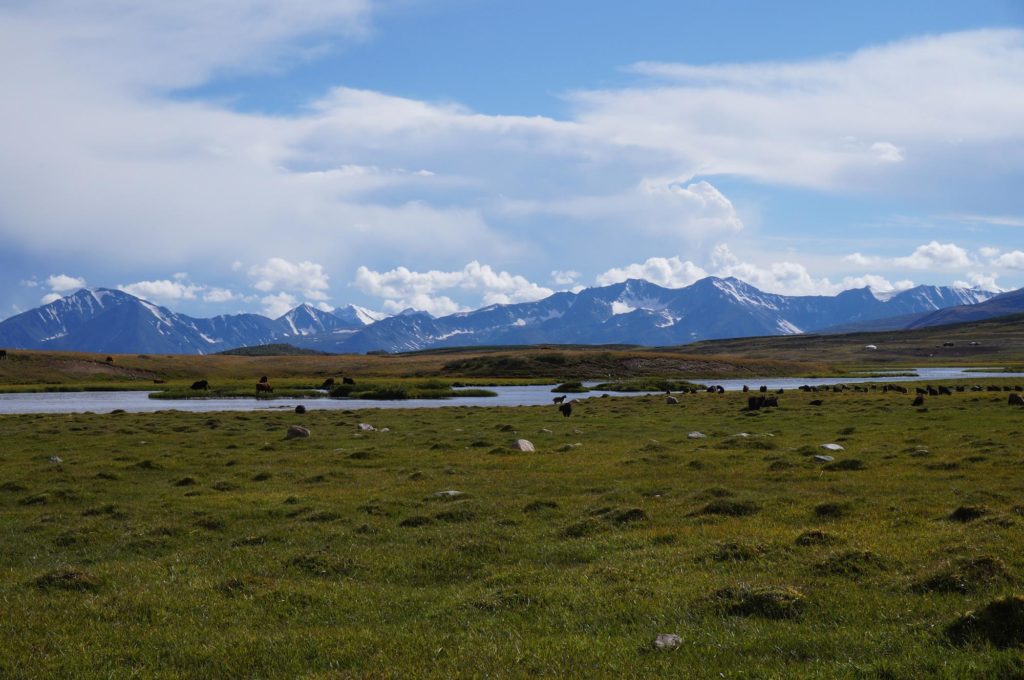Mongolia Field Note #2 ‣ Author: Caleb Pan
Above Photo: A mixed herd of goats and cattle graze in a high alpine meadow in the Altai Tavan Bogd. The river brings life to the healthy green grass and is fed by snow and glacier melt [Photo by Caleb Pan, August 2014].
The Altai Mountains of Mongolia form the western boundary between China and Mongolia and trend from the northwest to the southeast before terminating in the Gobi Desert. Although these mountains are not the most formidable with the highest peak reaching a modest 4374 m [Khüiten Peak], these mountains do facilitate a rare and important glaciated landscape, which as of 2010 cover a total area of 372 km2 (Kamp and Pan 2015). The Altai’s glaciated landscape may seem negligible and even meager when compared to other mountain complexes within the High Mountains of Asia [HMA]; but the importance of these glaciers must not be understated in understanding past, present, and future climates and as an invaluable water resource for herders and their livestock in an already water restricted [semi-arid] country.
Traveling back in time to the Pleistocene [27,000 – 20,000 BP] the global climate was far different from what we observe today and as a result, the glaciations of this era covered an astounding ~20,700 km2 (Lehmkuhl et al. 2004). As time moved forward the earth’s axial tilt began to change [these changes are known as Milankovitch cycles] and the Pleistocene Epoch began to naturally give way to the incoming Holocene Epoch [~11,000 BP]. The new influx of solar forcing caused global climates to warm and during this period the glaciers in the Altai began to dramatically decrease over the next few thousand years. It was recently discovered that in certain mountain ranges within the greater Altai complex, the glaciers disappeared. But in the mid-Holocene [~6,000 BP] the glaciers began to reappear. This neoglaciation is largely believed to be caused by a strong presence of the Indian Summer Monsoon which brings seasonal precipitation to the region by way of the Indian Ocean. This implies that the Altai’s modern glaciers are not remnants of the Last Glacial Maximum [LGM] but rather a neoglaciation during the mid-Holocene (Herren et al. 2013).
The Westerlies have again taken precedence in Mongolia’s climate in lieu of the Indian Summer Monsoon. This transition of climate influence engenders limited precipitation and increased evaporation, creating a semi-arid to arid environment inspiring glaciers to retreat. Throughout these shifts in climate, Milankovitch cycles, and glaciations, Mongolia has profited from vast wealth in water. In some areas, lake levels were up to 12 m higher than modern lake levels. However, these same lakes have been observed to completely disappear, leaving Mongolia water-destitute (Klinge and Lehmkuhl 2013). Fortunately, the glacier fed lakes in the Altai Mountains have seen only slight variations in lake levels over the past 20 years, remaining a consistent and reliable water resource for local herders. However as one moves east and to lower elevations, close to 68 lakes [larger than 1 km2] have disappeared from between 1990 to 2010 (Tao et al. 2015). Soon, the buffer provided by the glacier melt and altitude will no longer be able to defend the Altai’s lakes from impending aridity and the lakes may once again dry-up.

Number of total livestock in western Mongolia from 1970 to 2014 (Data from the Mongolian Statistical Information Service).
Fluctuations in water availability were never important up until recent history, when water became a resource. For the western aimags and the rest of Mongolia, regional livelihoods [agriculture, livestock, and mining] require access to water and are highly sensitive to the dynamic fluxes in climate. In western Mongolia and the Altai Mountains, livestock production has increased by over 5.1 million heads of livestock since 1970 (Mongolian Statistical Information Service). With respect to water, if these livestock were entirely sheep, which require 4 liters of water per day, 7.5 million more liters of water are required annually today than in 1970, exemplifying the attachment between livelihoods and water in Mongolia. The make-up of livestock in western Mongolia is not homogenous, but rather a mosaic of horses, cattle, camel, yak, sheep, and goat; this means the increase in annual water demand for livestock is likely higher than the estimated 7.5 million liters.
As we continue to observe the Altai’s glaciers recede and transform into remnant snow patches, it is only a matter of time before the glacier fed lakes are no longer fed by glaciers. Instead, the lakes will begin to evaporate and feed our atmosphere as the climate increases in aridity. The impact of glaciers disappearing and lakes drying-up after the LGM was of little importance because livelihoods did not exist. However, today herder livelihoods are fiercely attached to these sources of water that will likely continue on the path of their past.
References
Herren, P. A., A. Eichler, H. Machguth, T. Papina, L. Tobler, A. Zapf, and M. Schwikowski. 2013. The onset of Neoglaciation 6000 years ago in western Mongolia revealed by an ice core from the Tsambagarav mountain range. Quaternary Science Reviews 69:59-68.
Kamp, U., and C. G. Pan. 2015. Inventory of glaciers in Mongolia, derived from Landsat imagery from 1989 to 2011. Geografiska Annaler Series a-Physical Geography 97 (4):653-669.
Klinge, M., and F. Lehmkuhl. 2013. Geomorphology of the Tsetseg Nuur basin, Mongolian Altai – lake development, fluvial sedimentation and aeolian transport in a semi-arid environment. Journal of Maps 9 (3):361-366.
Lehmkuhl, F., M. Klinge, and G. Stauch. 2004. The extent and timing of late Pleistocene glaciations in the Altai and neighboring mountain systems. In: Quarternary Glaciations – Extent and Chronology: A Closer Look: 967-979.
Tao, S. L., J. Y. Fang, X. Zhao, S. Q. Zhao, H. H. Shen, H. F. Hu, Z. Y. Tang, Z. H. Wang, and Q. H. Guo. 2015. Rapid loss of lakes on the Mongolian Plateau. Proceedings of the National Academy of Sciences of the United States of America 112 (7):2281-2286.
About the Author
Caleb Pan’s research has been focused on Mongolian glaciers since 2011. He is currently in Mongolia on a Fulbright Research Grant working and collaborating with researchers from the Institute of Geography and Geoecology. In general, Caleb’s dissertation research is focused on improving geospatial data and technologies for environmental monitoring, as well as understanding the impacts of climate change on glaciers and lakes in western Mongolia. Caleb received his M.S. in Geography at the University of Montana in 2013 and has since conducted research on glaciers and glacier-hydrology in the high mountains of Mongolia, Ecuador, Tajikistan, Kyrgyzstan, and Nepal.


Keep up doing this awesome research! More expected…
Interesting! Correction: the Pleistocene Epoch began some 2.6 million years ago.